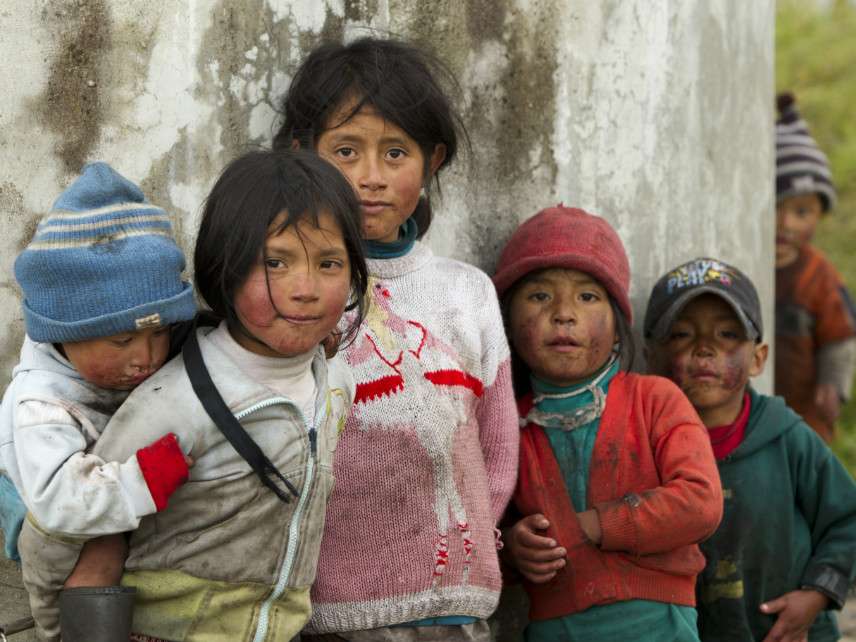Why Are Americans Adopting Fewer Foreign Children?
Global prosperity and government bureaucracy both play a role.

International adoptions are currently down 80 percent since 2004, according to a report from the State Department, marking an end to the high international adoption rate that persisted throughout the '80s, '90s, and early aughts. The reason might not be decreased demand but, in some cases, increased government meddling.
In 2004, there were nearly 23,000 children adopted into the United States. By 2014, that number had fallen to less than 7,000, and by 2017, that number was hovering around 4,700 according to State Department estimates. There are plenty of competing theories about why this is—some scholars claim the declining role of churches (especially evangelical ones) might be the culprit. Ryan Hanlon, the vice president of the National Council for Adoption, told NPR's Morning Edition on Monday that conflicts like World War II, the Korean War, and the Vietnam War have historically compelled people to open their homes to children in need.
Other experts agree. Ben Christopher, at the data visualization website Priceonomics, writes that "In the 1980s, civil war and poverty in Central and South America are reflected by an uptick in American adoption rates from El Salvador and Guatemala, and in the 1990s, we see the fall of the Iron Curtain in the rise of Romanian and Russian adoptions." As more and more immigrants get turned away from the southern border, and family separation gets more airtime and debate in U.S. politics, it will be interesting to see whether adoption from violence-ravaged parts of Latin America rises (though clearly only children without parents, not children separated from their parents, will be eligible).
The other part of the equation is global prosperity. As middle classes in China and South Korea grow, there's more of an internal push to keep children in their native countries.
In the '90s, China opened itself up for international adoption and quickly became the country with the most children adopted to the United States. Now, about 42 percent of the total U.S. international adoption pool consists of Chinese adoptees (still high, despite recent declines), but the Chinese government has removed the restrictive one-child policy and made a significant push in favor of domestic adoption within the country's borders. These changes are largely good for China—more children will now be raised by Chinese families, and the government is easing up on some of its more authoritarian policies. Now, demand for international adoption remains decently high in the U.S., while supply decreases.
For example, in December 2012, the Russian government banned adoptions to the United States. Earlier this year, the Ethiopian parliament passed new legislation which bans adoptions by foreigners, citing concerns about child welfare. Some countries have chosen to restrict adoption due to high-profile cases of child abuse and neglect. Others favor keeping children within their home country's borders for cultural reasons, and to signal to international observers that they can take care of their own.
Adoption costs have also grown over time. Per NPR, "many experts also argue that policies put in place over the years meant to regulate international adoptions actually make it more cumbersome and expensive." Unfortunately, many bureaucratic changes fly under the radar since so few people are tuned into international adoption news—in February of this year, for example, the State Department issued changes to the accrediting entity (AE) fee structure (AEs essentially hold up ethical standards for adoption agencies), creating a new agency called the International Adoption Accreditation and Maintenance Entity (IAAME).
Under the new fee structure, adoption agencies should see accrediting fees rise by nearly 800 percent annually. IAAME will also charge a fee of $500 for each adoption, which the State Department claims can easily be passed on from adoption agency to family. But in the past, certain fees have been waived or lumped together for sibling group adoptions, as an incentive for keeping siblings together. Now, those incentives will disappear.
In the past 10 years, the number of international adoption agencies has decreased from roughly 200 to 160. That number is expected to drop more as agencies deal with these expensive new licensing requirements and the bureaucratic headache of implementing vast changes to the already-complicated international adoption structure.
On one hand, it's good that so many feeder countries for international adoption are find ways to take care of children within their borders. On the other, changes in the structure of the American international adoption bureaucracy, and the starkly decreasing frequency of adoptions, might mean we're less prepared to take more children into our country in times of international crises, when they're most in need.




Show Comments (51)